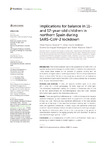Mostrar o rexistro simple do ítem
Implications for balance in 11- and 12-year-old children in northern Spain during SARS-CoV-2 lockdown
| dc.contributor.author | Ramos, Oliver | |
| dc.contributor.author | Arufe-Giráldez, Víctor | |
| dc.contributor.author | Sanmiguel-Rodríguez, Alberto | |
| dc.contributor.author | Navarro Patón, Rubén | |
| dc.date.accessioned | 2022-12-29T10:45:57Z | |
| dc.date.available | 2022-12-29T10:45:57Z | |
| dc.date.issued | 2022-09-21 | |
| dc.identifier.citation | Ramos-Álvarez O, Arufe-Giráldez V, Sanmiguel-Rodríguez A and Navarro-Patón R (2022) Implications for balance in 11- and 12-year-old children in northern Spain during SARS-CoV-2 lockdown. Front. Psychol. 13:1009299. doi: 10.3389/fpsyg.2022.1009299 | es_ES |
| dc.identifier.issn | 1664-1078 | |
| dc.identifier.uri | http://hdl.handle.net/2183/32247 | |
| dc.description.abstract | [Abstract] Introduction: The home lockdown due to the appearance of SARS-CoV-2 in Spanish society led to changes in certain habits in children and adolescents. These habits were related to the practice of physical activity and the implications of higher rates of sedentary activities. This lockdown lasted from March to June 2020. The aim of this study was to determine the implication that lockdown in Spain due to the SARS-CoV-2 virus outbreak had on balance in 11–12 year-old schoolchildren. Materials and methods: In total, 50 Spanish children aged 11–12 years (M = 11.40, SD = 0.50) participated, 33 (66%) boys and 17 (34%) girls. The Movement Assessment Battery for Children 2 (Movement ABC-2) and an ad hoc questionnaire for sociodemographic data and other relevant information were used for the three data collections. Results: There are significant differences (p < 0.05) in the results for balance variables measured by static balance tests on supports in the total sample, in boys and girls. There are also significant differences in the total sample as well as in the boys in the heel-toe backward walking test. In addition, there are significant differences in mean, scalar and percentile dimension scores for balance between before and after lockdown in both boys and girls. No significant differences were found in the total sample or by gender in measurements related to the zigzag jumping test with dominant as well as non-dominant leg in girls (p = 0.317). Conclusion: As a consequence of SARS-CoV-2 confinement, there was a worsening of balance values in children aged 11–12 years. | es_ES |
| dc.language.iso | eng | es_ES |
| dc.publisher | Frontiers Media SA | es_ES |
| dc.relation.uri | https://doi.org/10.3389/fpsyg.2022.1009299 | es_ES |
| dc.rights | Atribución 3.0 España | es_ES |
| dc.rights | Atribución 3.0 España | es_ES |
| dc.rights.uri | http://creativecommons.org/licenses/by/3.0/es/ | * |
| dc.subject | SARS-CoV-2 | es_ES |
| dc.subject | Physical activity | es_ES |
| dc.subject | Children | es_ES |
| dc.subject | MABC-2 | es_ES |
| dc.subject | Balance | es_ES |
| dc.title | Implications for balance in 11- and 12-year-old children in northern Spain during SARS-CoV-2 lockdown | es_ES |
| dc.type | info:eu-repo/semantics/article | es_ES |
| dc.rights.access | info:eu-repo/semantics/openAccess | es_ES |
| UDC.journalTitle | Frontiers in Psychology | es_ES |
| UDC.volume | 13 | es_ES |
Ficheiros no ítem
Este ítem aparece na(s) seguinte(s) colección(s)
-
UI- UNIDEF - Artigos [35]






